Assessable record - Study guides, Class notes & Summaries
Looking for the best study guides, study notes and summaries about Assessable record? On this page you'll find 59 study documents about Assessable record.
Page 4 out of 59 results
Sort by
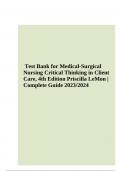
-
Test Bank for Medical-Surgical Nursing Critical Thinking in Client Care 4th Edition Priscilla LeMon Complete All Chapters
- Exam (elaborations) • 327 pages • 2023
-
- $39.49
- + learn more
Test Bank for Medical-Surgical Nursing Critical Thinking in Client Care 4th Edition Priscilla LeMon Complete All Chapters. A 45-year-old client voices concerns about gaining 12 pounds over the past two years. The client reports no change in dietary habits. Which response by the nurse is most appropriate? a. “Age-related changes in metabolism can result in weight gain despite consistent dietary intake.” b. “Are you exercising?” c. “You might be eating more than you think.” d. ...
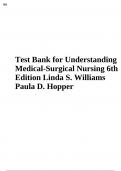
-
Test Bank Understanding Medical-Surgical Nursing 6th Edition Linda S. Williams Paula D. Hopper |Test Bank Chapter 1-52|
- Exam (elaborations) • 315 pages • 2023
-
- $17.49
- + learn more
Rationale: Grain intake should include at least six servings daily. To maintain a healthy weight and reduce incidence of cardiovascular disease, fat intake should not exceed 30% of the daily intake. Folic acid intake should be at 400 mg daily. Iron is a vital ingredient in the daily diet. 18 mg daily is reflective of the desired amount. Constipation should be managed by an adequate fluid and fiber intake. Nursing Process Step: Planning Client Needs Category: Health Promotion and Maintenanc...
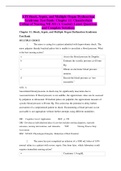
-
ATI Shock, Sepsis, and Multiple Organ Dysfunction Syndrome Test Bank: Chapter 11: Chamberlain College of Nursing NR 341 (A Graded) Latest Questions and Complete Solutions
- Exam (elaborations) • 35 pages • 2021
-
- $19.48
- 6x sold
- + learn more
ATI Shock, Sepsis, and Multiple Organ Dysfunction Syndrome Test Bank: Chapter 11: Chamberlain College of Nursing NR 341 (A Graded) Latest Questions and Complete Solutions Chapter 11: Shock, Sepsis, and Multiple Organ Dysfunction Syndrome Test Bank MULTIPLE CHOICE 1. The nurse is caring for a patient admitted with hypovolemic shock. The nurse palpates thready brachial pulses but is unable to auscultate a blood pressure. What is the best nursing action? a. Assess the blood pressure by Doppler....

-
MED SURG-CRITICAL CARE SHOCK AND SEPSIS
- Exam (elaborations) • 21 pages • 2023
-
- $27.99
- + learn more
MED SURG-CRITICAL CARE SHOCK AND SEPSIS Med surg-Critical care Shock and sepsis A student is caring for a client who suffered massive blood loss after trauma. How does the student correlate the blood loss with the client's mean arterial pressure (MAP)? a. It causes vasoconstriction and increased MAP. b. Lower blood volume lowers MAP. c. There is no direct correlation to MAP. d. It raises cardiac output and MAP. B ~ Lower blood volume will decrease MAP. The other answers are not accura...
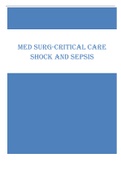
-
MED SURG-CRITICAL CARE SHOCK AND SEPSIS
- Exam (elaborations) • 21 pages • 2023
-
- $27.99
- + learn more
MED SURG-CRITICAL CARE SHOCK AND SEPSIS Med surg-Critical care Shock and sepsis A student is caring for a client who suffered massive blood loss after trauma. How does the student correlate the blood loss with the client's mean arterial pressure (MAP)? a. It causes vasoconstriction and increased MAP. b. Lower blood volume lowers MAP. c. There is no direct correlation to MAP. d. It raises cardiac output and MAP. B ~ Lower blood volume will decrease MAP. The other answers are not accura...
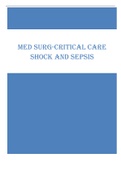
-
MED SURG-CRITICAL CARE SHOCK AND SEPSIS
- Exam (elaborations) • 21 pages • 2023
-
- $25.49
- + learn more
MED SURG-CRITICAL CARE SHOCK AND SEPSIS Med surg-Critical care Shock and sepsis A student is caring for a client who suffered massive blood loss after trauma. How does the student correlate the blood loss with the client's mean arterial pressure (MAP)? a. It causes vasoconstriction and increased MAP. b. Lower blood volume lowers MAP. c. There is no direct correlation to MAP. d. It raises cardiac output and MAP. B ~ Lower blood volume will decrease MAP. The other answers are not accura...
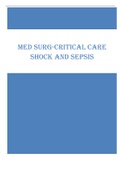
-
MED SURG-CRITICAL CARE SHOCK AND SEPSIS
- Exam (elaborations) • 21 pages • 2023
-
- $22.99
- + learn more
MED SURG-CRITICAL CARE SHOCK AND SEPSIS Med surg-Critical care Shock and sepsis A student is caring for a client who suffered massive blood loss after trauma. How does the student correlate the blood loss with the client's mean arterial pressure (MAP)? a. It causes vasoconstriction and increased MAP. b. Lower blood volume lowers MAP. c. There is no direct correlation to MAP. d. It raises cardiac output and MAP. B ~ Lower blood volume will decrease MAP. The other answers are not accura...
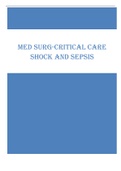
-
MED SURG-CRITICAL CARE SHOCK AND SEPSIS
- Exam (elaborations) • 21 pages • 2023
-
- $22.99
- + learn more
MED SURG-CRITICAL CARE SHOCK AND SEPSIS Med surg-Critical care Shock and sepsis A student is caring for a client who suffered massive blood loss after trauma. How does the student correlate the blood loss with the client's mean arterial pressure (MAP)? a. It causes vasoconstriction and increased MAP. b. Lower blood volume lowers MAP. c. There is no direct correlation to MAP. d. It raises cardiac output and MAP. B ~ Lower blood volume will decrease MAP. The other answers are not accura...
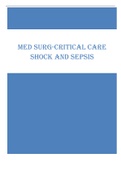
-
MED SURG-CRITICAL CARE SHOCK AND SEPSIS
- Exam (elaborations) • 21 pages • 2023
-
- $25.49
- + learn more
MED SURG-CRITICAL CARE SHOCK AND SEPSIS Med surg-Critical care Shock and sepsis A student is caring for a client who suffered massive blood loss after trauma. How does the student correlate the blood loss with the client's mean arterial pressure (MAP)? a. It causes vasoconstriction and increased MAP. b. Lower blood volume lowers MAP. c. There is no direct correlation to MAP. d. It raises cardiac output and MAP. B ~ Lower blood volume will decrease MAP. The other answers are not accura...
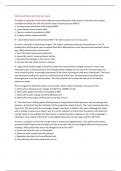
-
Med surg-Critical care Shock and sepsis
- Exam (elaborations) • 20 pages • 2024
-
- $12.99
- + learn more
Med surg-Critical care Shock and sepsis A student is caring for a client who suffered massive blood loss after trauma. How does the student correlate the blood loss with the client's mean arterial pressure (MAP)? a. It causes vasoconstriction and increased MAP. b. Lower blood volume lowers MAP. c. There is no direct correlation to MAP. d. It raises cardiac output and MAP. B ~ Lower blood volume will decrease MAP. The other answers are not accurate. A nurse is caring for a client after ...

That summary you just bought made someone very happy. Also get paid weekly? Sell your study resources on Stuvia! Discover all about earning on Stuvia


